Effective Strategies for Removing Well Water Stains
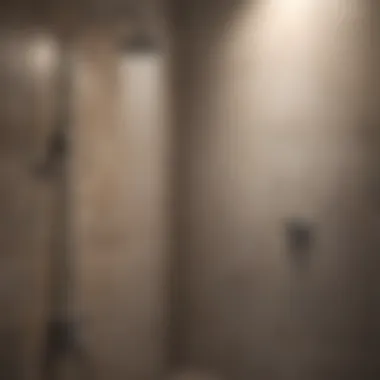
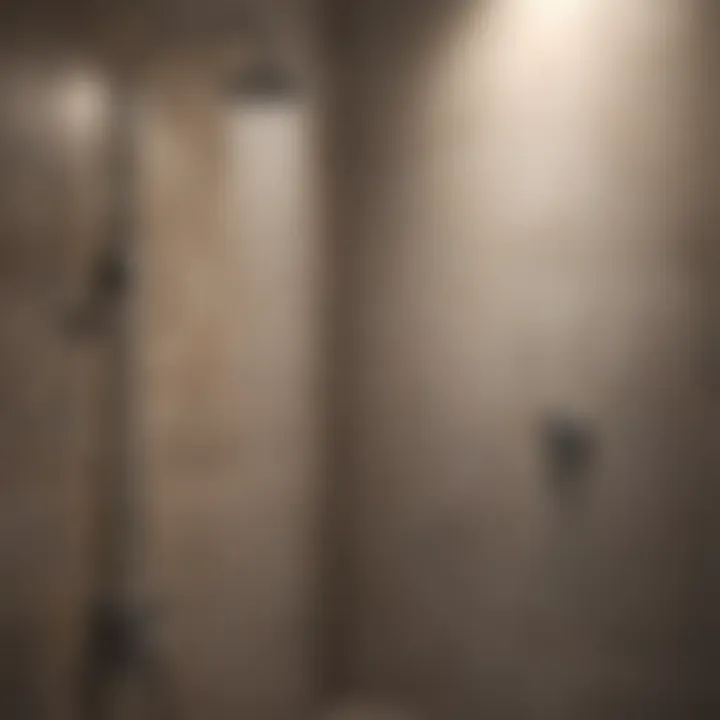
Intro
Well water can be a wonderful source of hydration for your home, but it often brings along with it a plethora of challenges. One of the most common issues is the appearance of stains in your shower, resulting from minerals present in hard water. These stains can be unpleasant, making your shower look unclean and neglected. Understanding how to remove these stains effectively can enhance the appearance of your bathroom while also improving your overall bathing experience.
In this article, we will explore several effective strategies and solutions tailored specifically for removing well water stains from showers. We will discuss the nature of these stains, present various cleaning solutions, and offer practical tips to help maintain a clean and fresh bathroom environment.
Our focus here is on homeowners seeking direct and reliable methods to tackle a common issue, while also emphasizing the importance of regular maintenance to prevent staining. By applying the techniques outlined here, you can restore and maintain the beauty of your shower.
Understanding the Nature of Hard Water Stains
The stains you see in your shower are primarily the result of hard water. When water comes from wells, it often contains high levels of minerals like calcium and magnesium. As water evaporates, it leaves these minerals behind, leading to white, chalky stains on various surfaces, including tiles and glass.
Why Hard Water Stains Form
- Evaporation: When water evaporates, minerals remain, contributing to buildup.
- pH Levels: Well water can have a high pH which enhances the formation of mineral deposits.
- Duration of Contact: The longer the water sits on surfaces, the more evident the stains become.
Understanding this process is crucial. It helps in selecting the right cleaning method to effectively combat these stubborn stains.
Effective Cleaning Solutions
Now, knowing what creates these stains informs how we can remove them. Below are several proven cleaning solutions you can apply:
Vinegar and Baking Soda
Mixing equal parts of vinegar and baking soda creates a natural cleaning paste. Apply it to stained areas and let it sit for 15 minutes before scrubbing gently.
Commercial Cleaners
Products such as CLR Calcium, Lime, and Rust Remover specifically target mineral deposits. Follow the instructions carefully, ensuring the area is well-ventilated during use.
Lemon Juice
Lemon juice is naturally acidic. Applying it to stains can help dissolve the calcium buildup. Just apply it directly to the stain and let it sit before rinsing.
Hydrogen Peroxide
For tougher stains, try focusing on hydrogen peroxide. Mix it with a few drops of dish soap and apply it directly to the affected areas.
Maintenance Strategies
Preventing stains before they form is always ideal. Here are some strategies:
- Regular Cleaning: Set a consistent cleaning schedule. Weekly quick cleanings can prevent buildup.
- Squeegee Use: After each shower, use a squeegee on glass surfaces to minimize water retention.
- Water Softeners: Consider installing a water softener system to reduce mineral content in your water. This can drastically reduce stain formation over time.
Epilogue
Utilizing these strategies will not only address existing stains but also empower you to maintain a clean and inviting shower in the long run. Remember, the goal is to create a space that is not only functional but also visually pleasing. By understanding the reasons behind the stains and implementing practical cleaning solutions, enhancing your bathroom's appearance can become an attainable reality.
Understanding Well Water Stains
Well water stains can present a significant challenge for homeowners. Understanding the nature of these stains is crucial for effective remediation and maintenance. Hard water often contains high levels of calcium, magnesium, and other minerals. When well water is used in showers, these minerals can precipitate onto surfaces, creating unsightly discolorations. This knowledge can help in selecting appropriate cleaning methods while minimizing damage to surfaces.
What Are Well Water Stains?
Well water stains primarily arise from minerals dissolved in the water supply. Typically, these stains appear as a white, brown, or rust-colored film on tiles, glass, and plumbing fixtures. The visual characteristics of these stains vary depending on the mineral composition of the water. For instance, a buildup of calcium can lead to chalky white deposits, while iron may yield reddish-brown stains. Identifying the specific type of stain can inform the best cleaning approach to take.
Causes of Stains in Showers
Stains in showers can be attributed to several factors:
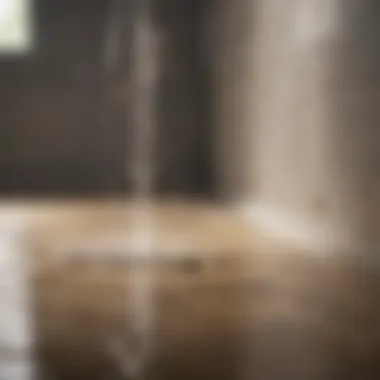
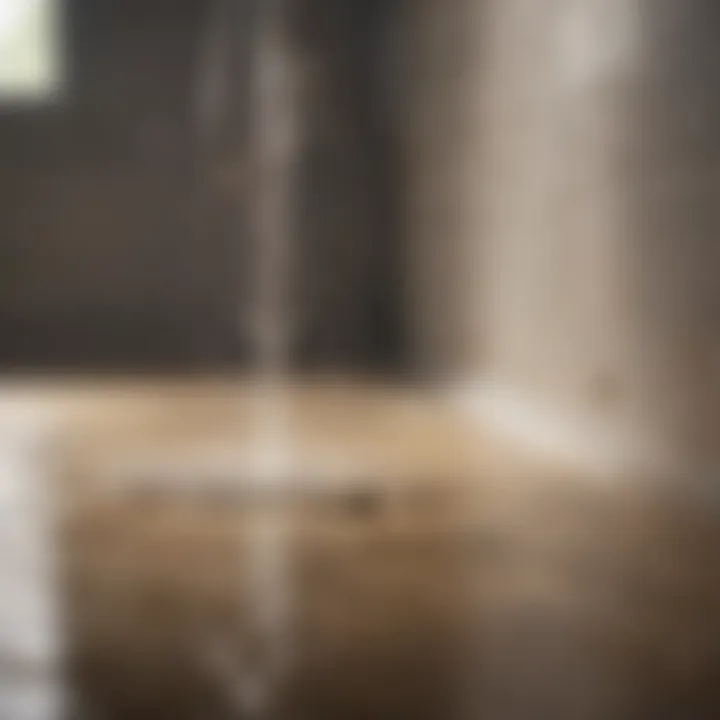
- Mineral Content: High levels of calcium, magnesium, and iron can lead to noticeable staining.
- Water Temperature: Hot water can cause minerals to precipitate more rapidly, leading to a greater accumulation of stains.
- Water pH: Acidic or alkaline water can affect how minerals behave, potentially increasing staining issues.
- Frequency of Use: Less frequent cleaning can exacerbate staining, as mineral deposits build up over time.
Each of these factors plays a role in the severity and appearance of well water stains.
Impact of Hard Water on Surfaces
Hard water can significantly affect the surfaces within a shower. Over time, the mineral deposits can corrode and scratch finishes. This degradation is not only visually unappealing but can also compromise the integrity of materials such as tile and acrylic. Regular exposure to hard water without preventive measures may lead to extensive damage that is both costly and labor-intensive to repair. By understanding this impact, homeowners can take appropriate steps to mitigate future problems.
Identifying Stain Types
Understanding the different types of stains that accumulate in a shower is crucial for effective cleaning and maintenance. Recognizing whether a stain is caused by mineral deposits, mold, mildew, or soap scum can directly influence the choice of cleaning products and techniques utilized. Each type of stain has its specific characteristics and removal methods that must be addressed differently to achieve the best results. This section aims to clearly delineate the three main types of stains you may encounter in your shower, empower homeowners with knowledge, and enhance overall bathroom hygiene.
Mineral Deposits
Mineral deposits are typically the most common type of stain found in showers, especially those using well water. These stains are primarily the result of high mineral content, particularly calcium and magnesium, found in hard water. When hard water evaporates, it leaves behind white, chalky residue that can accumulate over time.
These deposits not only look unattractive but can also damage shower surfaces if left untreated. They might begin as small spots and grow into larger, more stubborn patches that become difficult to remove. Regularly identifying and treating mineral deposits can prevent permanent staining and surface deterioration. Products such as vinegar or citric acid are often effective in dissolving these minerals when applied correctly.
Mold and Mildew Correlation
Mold and mildew thrive in damp environments, making showers a prime location for their growth. These types of stains appear as dark spots or patches, often black or green in color. They are not only unsightly but can also pose health risks, such as respiratory problems or allergies, for those exposed to their spores.
Identifying mold and mildew is essential, as improper cleaning methods may only spread the spores instead of removing them. Using specialized mold removers or a mixture of bleach and water can effectively eliminate these stains. Awareness of humidity levels and ensuring proper ventilation can help in reducing the likelihood of mold and mildew growth in the first place.
Soap Scum Contribution
Soap scum is another common shower stain, caused by the reaction between soap and minerals in hard water. It appears as a filmy residue that adheres to the surfaces and can vary in color. Over time, soap scum can become thick and very challenging to remove, making routine cleaning necessary to prevent buildup.
The presence of soap scum can also exacerbate the appearance of other stains, illustrating the importance of prompt identification. Cleaning products containing acids, like vinegar or lemon juice, can help dissolve soap scum effectively without damaging the shower surface.
In summary, understanding these three stain types—mineral deposits, mold and mildew, and soap scum—is vital for effective stain management in your shower. By accurately identifying the type of stain present, homeowners can select the appropriate cleaning methods and products, ensuring a cleaner and healthier bathing environment.
Essential Cleaning Supplies
When dealing with well water stains in your shower, the proper cleaning supplies are essential for effective stain removal. The efficiency of any cleaning endeavor hinges on the materials and tools used. This section will cover both natural cleaning agents and commercial products, as well as the necessary tools to ensure the best results.
Natural Cleaning Agents
Natural cleaning agents offer a safe and environmentally friendly alternative to commercial products. They are often less abrasive and can be very effective in removing stains. Common examples include:
- White Vinegar: Known for its acidity, vinegar can dissolve mineral deposits effectively. Its antifungal properties also help combat mold and mildew.
- Baking Soda: This abrasive powder can scrub away stuck stains without scratching surfaces. It works well in combination with vinegar for a powerful cleaning reaction.
- Lemon Juice: The natural citric acid in lemons can help break down hard water stains and leaves a fresh scent.
Using these agents is a straightforward process. Mixing baking soda with vinegar creates a bubbling reaction that can loosen stains. Applying these solutions allows for an effective clean without harsh chemicals.
Commercial Products Overview
There are numerous commercial products specifically designed to tackle well water stains. These may contain ingredients that specifically target calcium and other minerals. When choosing a product, consider the following aspects:
- pH Level: Products with a lower pH can be more effective against mineral deposits but may require careful application to protect surfaces.
- Targeted Use: Some products are made for specific surfaces like glass or tile, which can enhance effectiveness.
Popular brands to consider include Scrubbing Bubbles and CLR. Always read labels for instructions and safety warnings to ensure safe usage.
Tools for Effective Cleaning
The tools you use can significantly affect the cleaning process. The right tools help to apply solutions evenly, scrub efficiently, and reach into tight corners. Essential tools include:
- Scrubbing Brushes: Look for brushes with soft bristles to prevent damage while still being tough enough to tackle stains.
- Microfiber Cloths: These are ideal for wiping surfaces without leaving lint behind. They can be used wet or dry for various tasks.
- Squeegees: Especially important for glass surfaces, squeegees help prevent the buildup of water stains after each shower.
Having these supplies on hand not only aids in cleaning but also helps maintain your shower's appearance over time. An informed choice of cleaning agents and tools leads to a more effective cleaning routine.
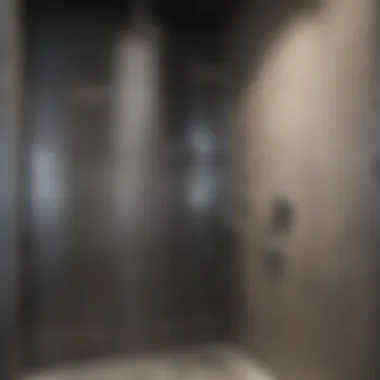
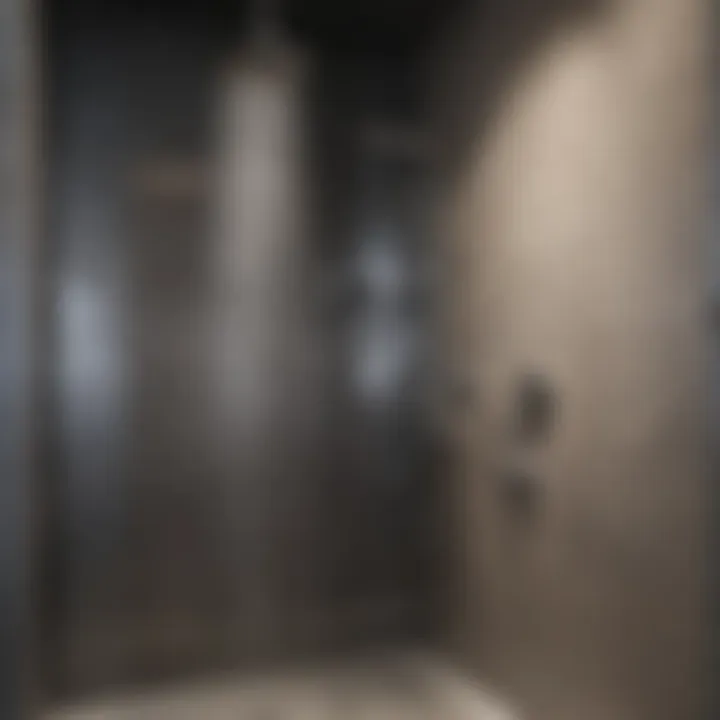
Step-by-Step Cleaning Methods
Cleaning well water stains requires a systematic approach. This section delves into the importance of outlined methods for effective cleaning. A structured method ensures that each part of the shower is addressed thoroughly, maximizing stain removal and minimizing potential damage.
Preparing the Shower Area
Before any cleaning begins, it is essential to prepare the shower area effectively. This preparation sets the tone for the cleaning process. First, remove all shower accessories such as shampoos, conditioners, and other toiletries. Clearing space allows for a comprehensive inspection of the stains.
Next, it is wise to lay down towels or a mat to catch any drips from cleaning agents. Protecting the floor can prevent slippery surfaces and unwanted messes. Ventilation is important too; opening a window or turning on an exhaust fan helps to dissipate fumes from cleaning agents. A well-ventilated area not only improves the cleaning environment but also protects the individual doing the cleaning from potential irritants.
Applying Cleaning Solutions
The choice of cleaning solution significantly impacts the effectiveness of stain removal. When applying cleaning solutions, it is vital to follow the manufacturer's instructions for the best results. Whether one opts for a commercial product or a homemade solution, coverage is key. Spray or apply the solution generously on the stained areas. Allow it to sit for several minutes. This dwell time enables the solution to penetrate and break down mineral deposits.
Natural solutions such as vinegar or lemon juice can be effective, but should be applied carefully. Take care to avoid any potential reactions with other chemicals. For best practice, test a small area to ensure no surface damage occurs. Consider consistency in application; ensuring the entire stained area is uniformly saturated can enhance the removal process.
Techniques for Scrubbing
Using the right technique for scrubbing is crucial for effective stain removal. A non-abrasive scrub brush or sponge is recommended to avoid damaging the shower's surface. Begin scrubbing with gentle pressure to prevent scratch marks or wear. It is beneficial to scrub in circular motions; this method helps to lift the stains effectively without pushing them deeper into the surface.
If stubborn stains persist, applying additional cleaning solution and letting it sit for longer periods may provide relief. For tile surfaces, using a toothbrush can offer precision, working on grout lines that may harbor buildups. Regular rinsing of the scrubber removes accumulated debris, keeping the working space clear and allowing for more effective cleaning.
Rinsing and Final Touches
After scrubbing, rinsing is a vital step. Use a handheld showerhead or a bucket to rinse away all cleaning agents. It is important to ensure no residue is left behind, as it can leave marks or attract more dirt. Once rinsed, wipe surfaces down with a clean cloth to prevent water spots from forming as they dry.
Lastly, evaluate the cleaned area. For hard-to-remove stains, it might be necessary to repeat the process. Keeping a close eye on the performance of the cleaning methods ensures that the effectiveness can be assessed.
"Regular maintenance coupled with effective cleaning methods can prolong the lifespan of your shower surfaces, preventing the recurrence of stains."
By following these step-by-step cleaning methods, homeowners can achieve a cleaner, stain-free shower. This effort contributes not only to aesthetics but to overall hygiene, providing a more pleasant experience.
Preventing Future Stains
Preventing stains from well water in your shower is essential for maintaining both hygiene and aesthetics. Regular cleaning and proactive measures can help minimize the buildup of mineral deposits and organic growths. A clean shower not only looks good but also contributes to a healthier environment for your family. Consequently, understanding prevention techniques can save homeowners time and effort in the long run.
Regular Cleaning Routines
Establishing a consistent cleaning routine is the foundation of preventing future stains. Ideally, the shower should be cleaned once a week. During this cleaning, focus on key areas where stains typically accumulate, such as corners and around fixtures. Use a combination of natural cleaning agents, like vinegar or baking soda, or choose commercial products specifically formulated for hard water stains.
- Tip: After each use, giving the shower a quick rinse can help reduce soap scum buildup.
- Tools: A squeegee can easily maintain surfaces and prevent water spots if used regularly.
Consistency and attentiveness to cleaning will greatly reduce the labor needed for deeper cleans later.
Water Softening Solutions
Water softeners are effective tools for combating hard water stains. These devices work by removing the minerals that cause water hardness, like calcium and magnesium. Installing a water softener in your home can lead to long-term benefits, such as reduced staining not only in your shower but throughout your plumbing system.
- Point to note: A water softening system can be costly, both in terms of initial investment and ongoing maintenance, so assess your water quality first.
- Additional benefit: Softened water often improves the performance of soaps and detergents, leading to less residue buildup overall.
By applying this solution, you will significantly reduce the occurrence of future stains while enhancing your cleaning efforts.
Sealing Shower Surfaces
Another effective preventative measure is sealing your shower surfaces. This process involves applying a protective layer over tiles and grout, which helps to prevent stains from adhering to the surfaces. While applying a sealant may require some time and effort, the long-term benefits far outweigh the initial work.
- Choose a quality sealant: When selecting a sealant, opt for products made for the specific material of your shower, whether it's tile, stone, or glass.
- Reapplication: Depending on the brand, sealants should be reapplied every six months to a year, so stay organized with a schedule to ensure effectiveness.
Sealing creates an additional barrier against stains and makes future cleaning easier. Taking these steps ensures your shower remains clean with minimal effort.
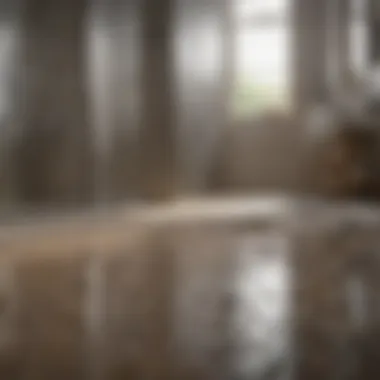
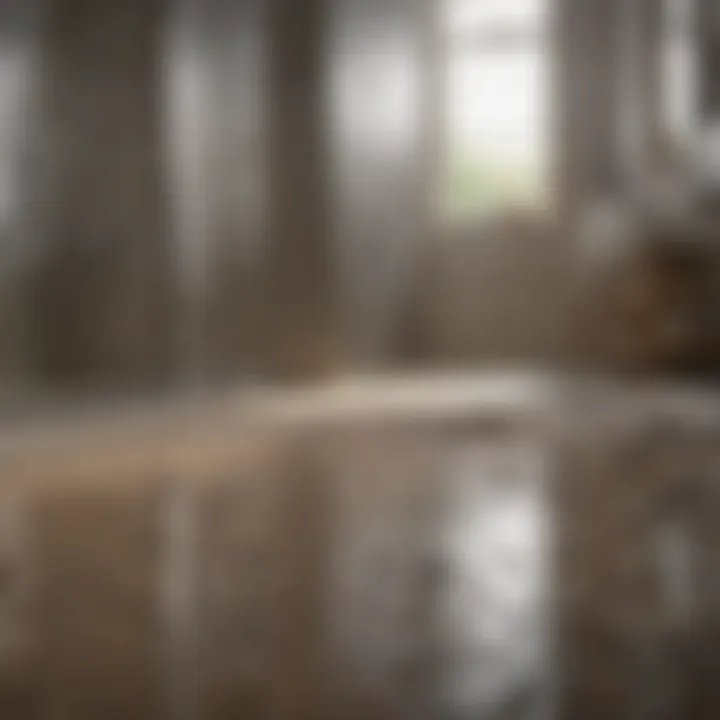
Alternative Solutions
Alternative solutions are crucial in the battle against well water stains. They provide homeowners with options beyond commercial products, often relying on common household substances. These approaches are generally safer for both the environment and human health. Moreover, they can be cost-effective, tapping into the principle of using what one already has at home.
When exploring alternative cleaning methods, it is essential to consider the effectiveness of the chosen materials. Some solutions might work well for minor stains yet fall short against tougher deposits or mildew. Additionally, when cleaning, the safety of the materials is a priority. An informed choice can prevent potential harm to both the surface being cleaned and the individual performing the task.
Using Vinegar and Baking Soda
Vinegar and baking soda are two powerhouse cleaners that have a significant reputation for tackling stains from well water. Their effectiveness lies in their chemical properties. Vinegar is acidic, meaning it can dissolve mineral deposits left behind by hard water. Baking soda, on the other hand, is a mild abrasive, making it suitable for scrubbing away grime without scratching surfaces.
To use these ingredients, follow these simple steps:
- Mixing the Solution: Create a paste by combining equal parts baking soda and vinegar. The reaction will create a fizzing effect. Allow the mixture to calm down before use.
- Applying the Paste: Spread the paste over the stained areas in your shower. It is wise to focus on spots with heavier deposits.
- Let it Sit: Allow the paste to sit for at least 15-20 minutes. This gives the vinegar time to break down the mineral buildup.
- Scrubbing: After the sit time, lightly scrub the area with a soft-bristle brush or sponge. The baking soda acts as a gentle abrasive, aiding in stain removal.
- Rinsing: Finally, rinse the area thoroughly with warm water. Ensure that all the paste is washed away.
Using vinegar and baking soda not only helps in removing stains but also leaves a fresh scent.
Essential Oils for Odor and Stain Control
Essential oils have found their way into cleaning routines thanks to their antiseptic properties and pleasant fragrances. They can enhance the effectiveness of your cleaning efforts on well water stains, particularly in controlling odors and providing a refreshing smell after cleaning. Oils like tea tree and lavender are often recommended.
To utilize essential oils:
- Mixing: Add a few drops of your chosen essential oil to a cleaning solution made from vinegar or mild soap. This enhances the cleaning process while providing a pleasant scent.
- Spraying: Fill a spray bottle with this mixture. Use it to spray the affected areas in your shower, particularly where lingering odors or stains are present.
- Let it Soak: Allow the mixture to sit for a brief period, typically 10-15 minutes, which allows the essential oil to penetrate and act on the stains.
- Scrubbing and Rinsing: Follow the same scrubbing and rinsing steps as previously mentioned to ensure removal of all residues.
Adding essential oils can personalize the cleaning experience, making it not only effective but also enjoyable.
Alternative solutions to common cleaning challenges empower homeowners to take control of maintenance tasks while enhancing the safety and efficiency of their methods.
When to Seek Professional Help
In the pursuit of a clean shower, homeowners often encounter stains from well water that seem impossible to remove with basic cleaning methods. Understanding when to enlist professional help is crucial for maintaining not just the appearance but also the functionality of your shower. This section delves into the signs indicating that professional intervention might be necessary, as well as the importance of evaluating damage effectively.
Signs of Severe Staining
When assessing the condition of your shower, certain signs can indicate that the staining has progressed beyond what is manageable through DIY methods. These include:
- Persistent discoloration: If stains continue to appear after multiple cleaning attempts, it may indicate an underlying issue.
- Hard water buildup: Significant mineral deposits that feel gritty or sandy often require specialized equipment for removal.
- Cracks or chips in the surface: If the surface of your shower shows signs of damage connected to staining, professional help is essential to prevent further deterioration.
- Mold or mildew growth: If not properly addressed, mold can compromise your health and may need professional remediation to ensure total removal.
Recognizing any of these signs should prompt you to consider contacting a professional service. Ignoring these issues can lead to more severe damage that could be costly to repair.
Evaluating Damage
Assessment of the damage caused by well water stains is vital before proceeding with any cleaning strategies. Here are some key factors to consider during this evaluation:
- Extent of staining: Analyze the severity and coverage of stains in your shower. If they are widespread, this may indicate a deeper problem with your water supply.
- Material of the shower: Different materials, such as fiberglass, porcelain, or tile, react differently to stains and cleaning solutions. Professional services have the expertise to deal with specific materials without causing harm.
- Impact on fixtures: Inspect faucets, showerheads, and drains for any signs of mineral buildup. Over time, this can affect water flow and pressure, leading to more significant plumbing issues.
- Underlying issues: Often, persistent staining points to problems with the well system itself. A professional can assess water hardness and analyze the need for filtration or treatment systems.
"Addressing well water stains early can save extensive damage and maintenance costs later."
Culmination
Addressing well water stains is more than just a task for aesthetics; it is fundamentally about maintaining the integrity and hygiene of your shower surfaces. The process of removing these stains requires a systematic approach that combines effective cleaning techniques, good maintenance practices, and understanding the nature of the water supply. It is necessary for homeowners to be informed about their specific water conditions to choose the best strategies for their needs.
Recap of Effective Methods
In the battle against well water stains, several strategies have proven effective:
- Natural Cleaning Agents: Utilizing common household items such as vinegar and baking soda can provide safe yet powerful cleaning solutions.
- Commercial Products: Consider products specifically designed to deal with hard water stains, such as CLR Calcium Lime Rust Remover or Iron Out. These can offer potent results in tougher situations.
- Tools for Effective Cleaning: A good scrubber, sponge, or even an old toothbrush can make a significant difference in the outcome of your cleaning efforts.
Regular application of these methods can lead to a cleaner, more inviting shower environment.
Final Thoughts on Maintenance
Preventing future stains is as vital as removal. Establishing a regular cleaning routine, such as weekly maintenance, can help keep the buildup at bay. Consider the use of a water softening system to mitigate the hardness of the water entering your home. Additionally, sealing the shower surfaces can provide an extra layer of protection, making it easier to clean and prolonging the life of the surfaces.
Ultimately, adhering to these maintenance strategies not only enhances the appearance of your shower but also extends its lifespan and efficiency, contributing to a healthier living environment for you and your family.



